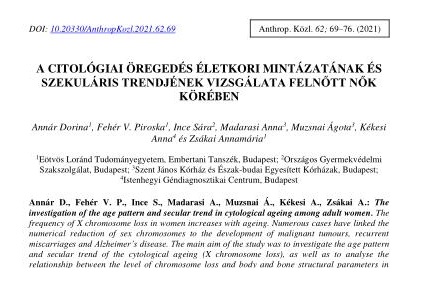A citológiai öregedés életkori mintázatának és szekuláris trendjének vizsgálata felnőtt nők körében
Absztrakt
The frequency of X chromosome loss in women increases with ageing. Numerous cases have linked the numerical reduction of sex chromosomes to the development of malignant tumours, recurrent miscarriages and Alzheimer’s disease. The main aim of the study was to investigate the age pattern and secular trend of the cytological ageing (X chromosome loss), as well as to analyse the relationship between the level of chromosome loss and body and bone structural parameters in adult women.
Twenty-one women aged between 20–40 years were enrolled to the present study. Body mass components were estimated by body impedance analysis, bone structure was estimated by quantitative ultrasound technique. Cellular ageing was assessed by X chromosome loss estimation (using FISH probe).
The results revealed an increased level of X chromosome loss in women aged between 21–30 compared to their age-peers lived decades before, and women aged between 31–40 and studied in 2021. By considering the body and bone structural profile (another indicator of their biological status) of women in the younger age-group, an increased fat component and a decreased skeletomuscular component could be described in this age-group.
The results are rather preliminary, that aimed to explore explanatory components in the changes in the rate of X chromosome loss. In order to establish the findings, further investigations, as well as the increase of the sample size is required.
Hivatkozások
Annár, D., Fehér, P., Madarasi, A., Mascie-Taylor, N., Kékesi, A., Kalabiska, I., Muzsnai, Á., Zsákai, A. (2021): Body structural and cellular aging of women with low socioeconomic status in Hungary: A pilot study. American Journal of Human Biology, e23662. DOI: https://doi.org/10.1002/ajhb.23662
Beregi, E. (1984): Az öregedés: Biológiai elváltozások, megbetegedések és szociális problémák öregkorban. Budapest, Akadémiai Kiadó.
Christensen, K., McGue, M. (2016): Healthy ageing, the genome and the environment. Nature Reviews Endocrinology, 12(7): 378–380. https://doi.org/10.1038/nrendo.2016.79
Drinkwater, D., Ross, W.D. (1980): Anthropometric fractionation of body mass. Kinanthropometry, II(9): 178–189.
Dumanski, J.P., Lambert, J.C., Rasi, C., Giedraitis, V., Davies, H., Grenier-Boley, B., Lindgern, C.M., Campion, D., Pasquier F., Amouye, P., Lannfelt, L., Ingelsson, M., Kilander, L., Lind, L., Forsberg, L.A. (2016): Mosaic loss of chromosome Y in blood is associated with Alzheimer disease. American Journal of Human Genetics, 98: 1208–1219. DOI: https://doi.org/10.1016/j.ajhg.2016.05.014
Galloway, S.M., Buckton, K.E. (1978): Aneuploidy and ageing: chromosome studies on a random sample of the population using G-banding. Cytogenetic and Genome Research, 20(1-6): 78–95. DOI: https://doi.org/10.1159/000130842
Guttenbach, M., Koschorz, B., Bernthaler, U., Grimm, T., Schmid, M. (1995): Sex chromosome loss and aging: in situ hybridization studies on human interphase nuclei. American Journal of Human Genetics, 57(5): 1143–1150.
Iván, L. (2002) Az öregedés aktuális kérdései. Magyar Tudomány, 2002(4): 412–418.
Lopez-Otin, C., Blasco, M.A., Partridge, L., Serrano, M., Kroemer, G. (2013): The hallmarks of aging. Cell, 153(6): 1194–1217. DOI: https://doi.org/10.1016/j.cell.2013.05.039
Noveski, P., Madjunkova, S., Stefanovska, E.S., Geshkovska, N.M., Kuzmanovska, M., Dimovski, A., Plaseska-Karanfilska, D. (2016): Loss of Y chromosome in peripheral blood of colorectal and prostate cancer patients. PLoSOne, 11(1): e0146264. DOI: https://doi.org/10.1371/journal.pone.0146264
Page, J. M., Silver, R. M. (2016): Genetic causes of recurrent pregnancy loss. Clinical Obstetrics and Gynecology, 59: 498–508. DOI: https://doi.org/10.1097/GRF.0000000000000217
Pampalona, J., Soler, D., Genesca, A., Tusell, L. (2010): Whole chromosome loss is promoted by telomere dysfunction in primary cells. Genes, Chromosomes and Cancer, 49(4): 368–378. DOI: https://doi.org/10.1002/gcc.20749
Partridge, L., Fuentealba, M., Kennedy, B. K. (2020): The quest to slow ageing through drug discovery. Nature Reviews Drug Discovery, 19(8): 513–532. DOI: https://doi.org/10.1038/s41573-020-0067-7
Russell, L.M., Strike, P., Browne, C.E., Jacobs, P.A. (2007): X chromosome loss and ageing. Cytogenetic and Genome Research, 116: 181–185. DOI: https://doi.org/10.1159/000098184
Weiner, J.E., Lourie, J.A. (1969): Human Biology. A Guide to Field Methods. IBP Handbook No. 9. Blackwell, Oxford.
Zsákai, A., Bodzsár, É.B. (2014): A menopauzakor és a reprodukciós történet néhány tényezője közötti kapcsolatrendszer Anthropologiai Közlemények, 55: 45–52.
Zsákai, A., Karkus, Z., Utczás, K., Biri, B., Sievert, L. L., Bodzsár, É.B. (2016): Body fatness and endogenous sex hormones in the menopausal transition. Maturitas, 87: 18–26. DOI: https://doi.org/10.1016/j.maturitas.2016.02.006
Zsákai, A., Sipos, R., Takács-Vellai, K., Szabó, A., Bodzsár, É.B. (2017a): The relationship between reproductive and biochemical ageing in menopausal transition. Experimental Gerontology, 98: 162–168. DOI: https://doi.org/10.1016/j.exger.2017.08.028
Zsákai, A., Macsie-Taylor, N., Bodzsár, É. (2017b): Ageing of Bone Structure and the Risk of Osteoporosis in the Menopausal Transition. Journal of Womens Health Issues & Care, 6(3): 1–4. DOI: https://doi.org/10.4172/2325-9795.1000272




